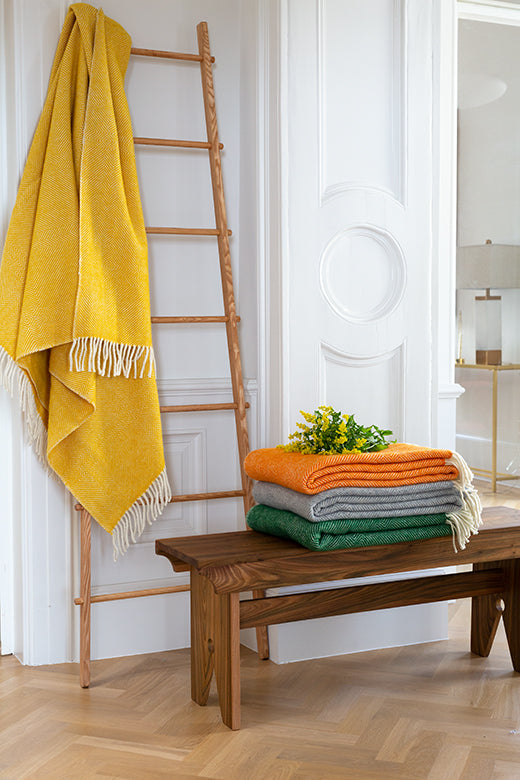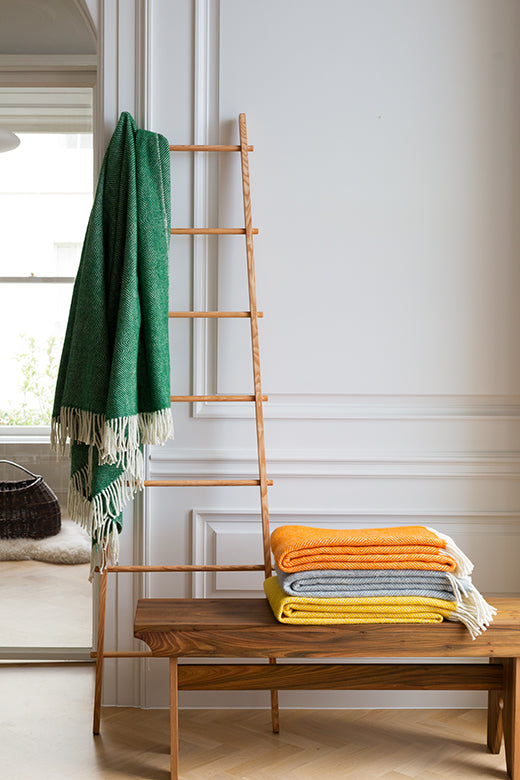Journal
Subheading
Ballymaloe Bread Shed Sourdough Recipe by Rory O'Connell
This recipe is one in a series from Rory as a pairing with our STABLE Summer 2024 Irish Linen Napkins.
Easy Sourdough Bread made by the Folding Method
Makes 1 loaf. Remember “Sourdough bread is an inconsistent medium of nature”. Every loaf will be slightly different depending on the activity of the starter. Making a loaf of sourdough bread by this method is a three day process which once you get started, will soon become a routine part of your day.
Ballymaloe Sourdough Starter
It will take approximately seven days to establish an active sourdough starter before you make your first loaf. Once the starter is established, it’s only a matter of feeding. Remember it’s live and just like us, it gets hungry…

Starter Tips
- Your starter should smell distinctively beery, slightly yeasty and fermented, and it should be thick and bubbly. It may become thin and bubbly or develop a layer of grey liquid on top, a sign it’s hungry.
- Starter grows best at comfortable room temperature (18-21°C/64-70°F).
- If the starter is too thick to beat easily, add a little more water.
- The flavour will grow more complex with use and age.
- Once the sourdough starter is established, depending on how lively the starter is, making a loaf of sourdough bread from start to finish will take anywhere from 24 to 48 hours.
- Remember yeast freezes perfectly.
How to make a natural sourdough starter.
Day 1: Choose a large airtight 500ml to 1 litre Kilner jar.
Put 60g of cold water and 60g of organic strong white flour (bakers’ flour) into the jar, mix well with a long handled spoon. Close the jar and leave at room temperature for 24 hours.
Day 2: You should begin to see some bubbles at this stage, add 60g cold water and 60g organic strong white flour (bakers’ flour). Mix well, close the jar and leave for 24 hours at room temperature
Day 3: Add 60g cold water and 60g organic strong white flour (bakers’ flour). Mix well, close the jar and leave for 24 hours at room temperature.
Day 4: Add 60g cold water and 60g organic strong white flour (bakers’ flour). Mix well, close the jar and leave for 24 hours at room temperature.
Day 5: Add 50g cold water and 50g organic strong white flour (bakers’ flour). Mix well, close the jar and leave for 24 hours at room temperature.
Day 6: Add 60g cold water and 60g organic strong white flour (bakers’ flour). Mix well, close the jar and leave for 24 hours at room temperature. Your sourdough starter will now be very runny and bubbly, it’s hungry and ready to proceed to the next stage.
Day 7
Reduce the starter in the jar to about 100g (discard the excess starter or use to make sourdough crackers). Thicken it with about 50g to 100g of organic strong white flour (bakers’ flour). Give it a 2nd feeding of 140g of cold water. Stir in well. Add 140g of organic strong white flour (bakers’ flour), stir well and allow to stand overnight. This is very much weather dependent (you may leave it out in the Winter or refrigerate in the Summer) it should be thick and bubbly, a good indication is if it floats in water, this is the stage we now call “a sponge” “a levain” or “biga”, “an active yeast” ready to use. The more you use it the stronger it gets, in fact, the first few loves may be disappointing, but please persevere.
Day 8
Next morning.
The sponge should be thick and bubbly.
114g sourdough starter/natural levain
334g warm water
100g Doves organic malt flour
337g white organic bread flour
33g organic dark rye flour
5g wheat germ
OR
476g Ballymaloe Bread Shed flour mix
In a large bowl, mix all the above ingredients to a loose dough. Rest uncovered at room temperature for 20-30 minutes.
Add 11g of pure salt.
Feed the starter.
While the mixture is resting, feed the starter by adding 50g of cold water plus 80g of organic strong white flour (bakers’ flour).
If you plan to make a batch of bread the following day, allow to stand at room temperature for 2-3 hours, then return to the fridge. Otherwise, return to the fridge immediately after feeding which will slow down the yeast activity.
In order to develop the gluten in the bread dough, you will need to stretch and fold the dough every 20-30 minutes for 3 hours. Be very gentle in the beginning, so as not to tear the dough. The gluten will start to develop, and you will be able to stretch it quite far.
After 3 hours, place into a covered bowl for 24 hours in the fridge.
Day 9
Next day.
Transfer the dough from the bowl onto the counter. Knock back by kneading lightly with both your hands, tighten into a large ‘bun’. Allow to relax uncovered for 10-15 minutes. With a dough scraper, flip over onto the counter. Knock back once again and fold the dough in on itself. Turn over with the fold underneath and tighten into a large ‘bun’ once again. Transfer upside down into a cloth lined banneton and leave, covered in the fridge for another 24 hours.
Day 10
Following day.
For baking sourdough.
We recommend using a Dutch oven, or other cast iron pots.
Preheat to 260°C/500°F.
Put the Dutch oven into preheat.
When fully preheated (approx. 30 minutes), with thick oven gloves, remove the pot from the oven. Line the base of the pot with a round of parchment paper and gently lower the dough into the pot. Slash the top with a sharp knife.
Replace the hot lid on the pot and return to the oven. Reduce the temperature to 230°C and set the timer for 25 minutes. Then remove the lid and continue to bake for further 10-15 minutes, until dark golden brown.
When cooked, the bread will feel light and sound hollow when tapped on the base with your fingers.
Cool on a wire rack.
Cut with a serrated bread knife and enjoy!










